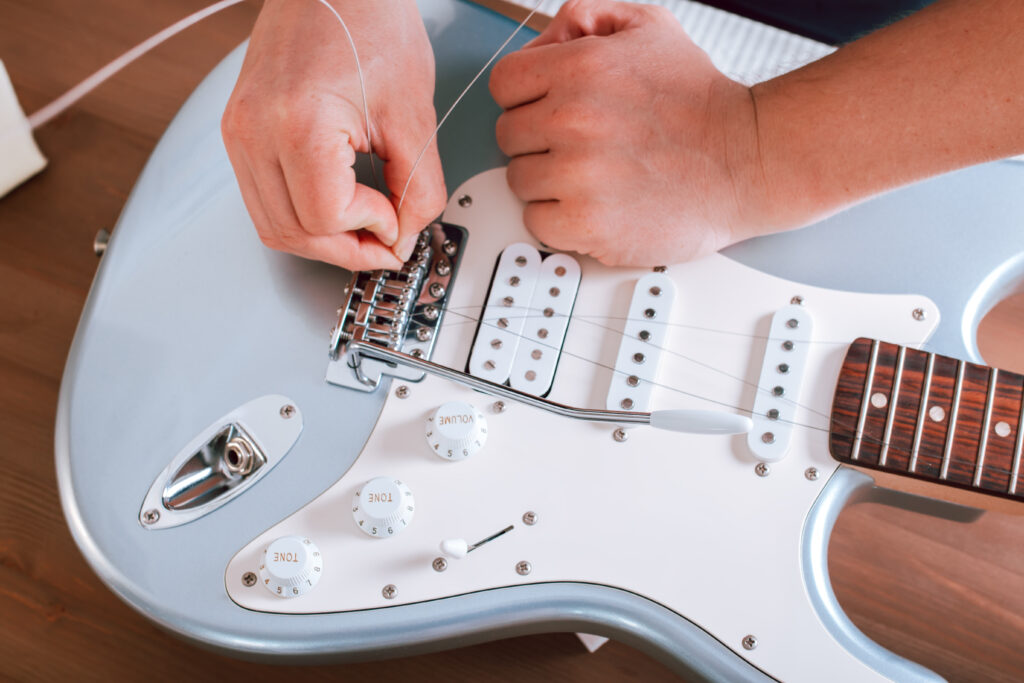
This article “Different Types of Guitar Strings” was kindly contributed by guest writer Shawn Leonhardt of Guitar Tricks and 30 Day Singer.
Strings are one of the most important aspects when it comes to the sound of your guitar. Especially as a beginner guitar player, having fresh strings is the most important factor in keeping your guitar in tune and sounding fresh.
These days there are a variety of brands (such as Ernie Ball, Elixir, Rotosound and D’Addario) materials, and builds that produce strings with varying tones and qualities. And save for a few rules there is no exact science to finding the right strings. Your best bet is to get acquainted with string basics and then try out different types of guitar strings.
“The guitar is a small orchestra. It is polyphonic. Every string is a different colour, a different voice.” – Andres Segovia
Skip Ahead
Materials in Acoustic and Electric Guitar Strings
String Construction
Windings
String Gauges and Sizes
Which Strings Are Best For You?
Materials in Acoustic and Electric Guitar Strings
The strings for an acoustic guitar are going to be different than those of an electric, they are thicker as they need to project more sound. The electric guitar only needs to pick up the signals so they can be a lot thinner and easier to manipulate.
If you are only starting your guitar lessons, some of these types of strings might not be for you. But it’s good to know what’s out there.
Gut
Originally acoustic instrument strings were made from animal gut, and you can still find strings made in this manner. However, they don’t match up to the sound projection of modern-day materials. They provide a unique tone and may be suitable for those who are into classical acoustic styles, but modern strings have better sonic qualities.
Nylon
Modern synthetic materials like nylon have replaced gut as they have a better response in both the bass and treble. While you cannot place steel strings on a classical guitar, some nylon strings have light metal coatings to help with deeper bass. This allows for better sound without too much extra tension. Silver-plated nylon cores are common for classical guitars.
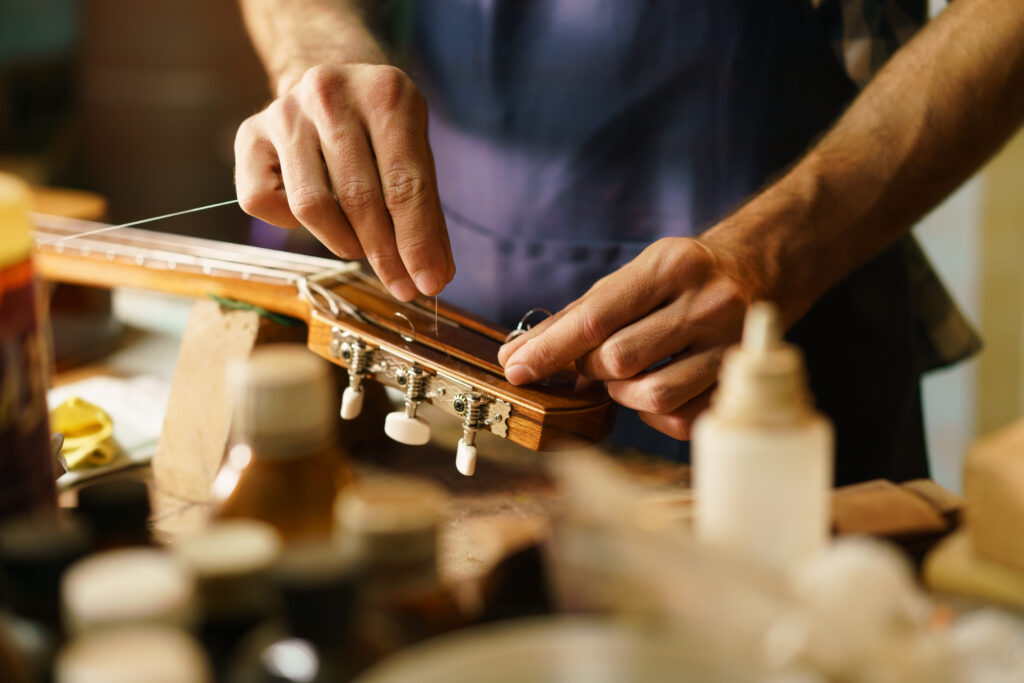
Fluorocarbon
Another synthetic string is fluorocarbons, they are known for having a richer sound as they are a little thicker than regular nylon strings. They also have silver, copper, and other metal coatings to aid in their overall boosted sound projection. There are many varieties these days of synthetic strings with and without metal coatings and they are usually affordable so you can try different kinds out.
Silk and Steel
Long before they were wrapping silver and copper over synthetics there were simple silk and steel strings. These used metal wound steel over silk and so they gave the acoustic guitar a deeper sound and more volume. And at the same time, they didn’t have as much tension as pure steel.
80/20 Bronze
Some acoustic guitar strings use different mixtures of bronze. With 80/20 Bronze strings, the ratio is 80% copper and 20% zinc. Bronze strings are best for larger acoustic guitars, they seem to give them the best overall sound quality.
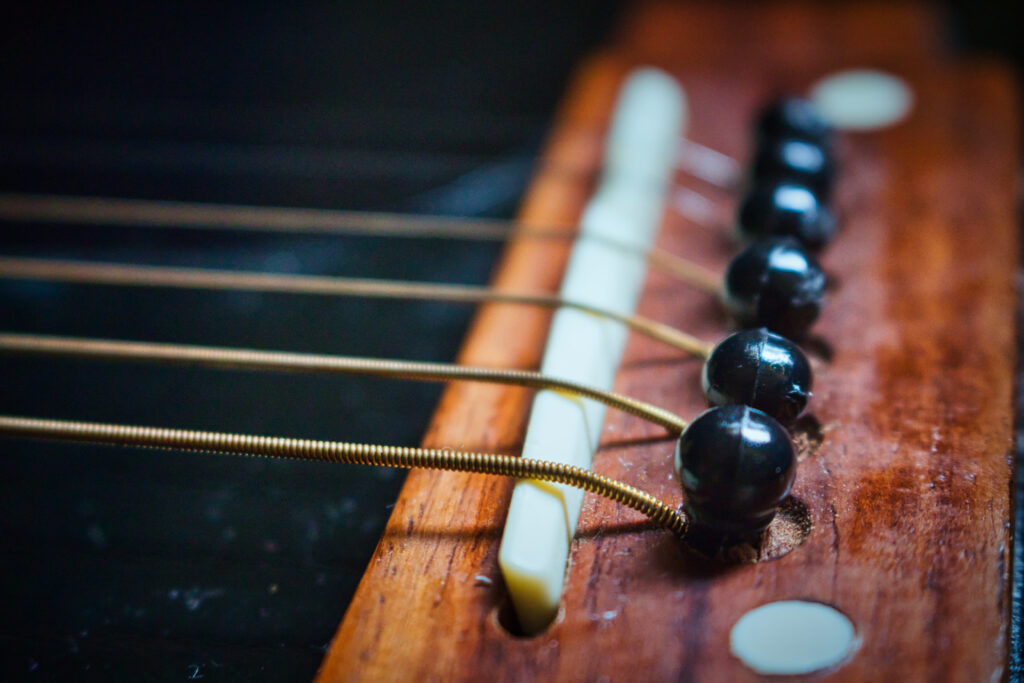
Phosphor Bronze
Bronze strings can have different levels of metals and even other chemicals mixed in like phosphorus. This chemical can increase the life of the string and make them more durable, but some feel it is not as bright with this mixture. If you have a dreadnought, jumbo, or other larger acoustic guitar it is best to try out different bronze mixtures and coatings. These will be the most common string type when you are learning how to play guitar.
Steel
Of course, acoustic guitars can use steel strings, but electric guitars have always used steel as their main component. The steel makes a proper soundwave for the pickup to grab that is bright and loud. In fact, sometimes they are too bright which leads us to the coatings!
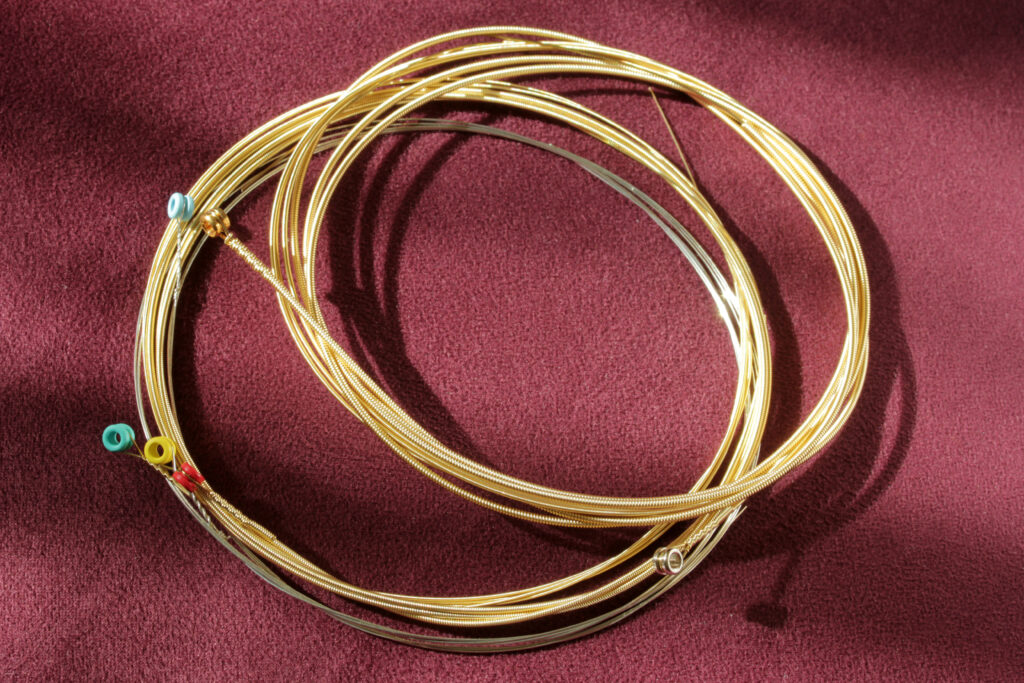
Nickel Plated
By plating steel electric guitar strings in nickel, we tamp down some of the overly bright sound without the coating. These are usually the most common strings to buy as they are quite versatile and great for tone and amplification.
Nickel
If we use plain nickel we cut the brightness down even more to get a mellow tone compared to steel or just a coating. And like acoustic guitar strings, there are many more metals and coatings used, like the ones mentioned above and cobalt. If you look hard enough you can find all sorts of metal alloys for guitar strings!
Jump Back To The Start
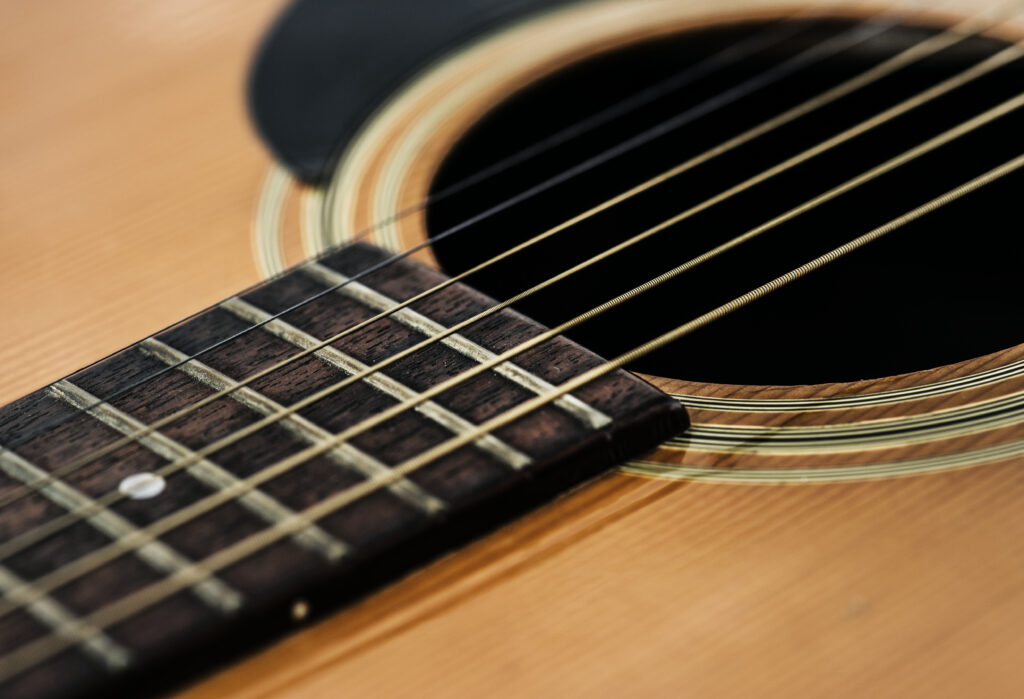
String Construction
Both acoustic and electric guitar strings can have cores, coatings, and even further protective layers added to the overall construction. Back in the day, strings used to be a little more straightforward. Now, we have quite a variety of builds available.
Hex Core
This is named because of its hexagon shape, which allows the outer coating of the string to have a better grip. These are usually preferred because they stay in tune better thanks to this construction.
Round Core
And here of course we have a round core, which is not as strong of a hold but it provides more sustain and a mellow sound. However, as string-building technology gets better round cores are not that bad at losing their tune. Give both cores a try to see which is preferable on your guitar and playing.
Jump Back To The Start
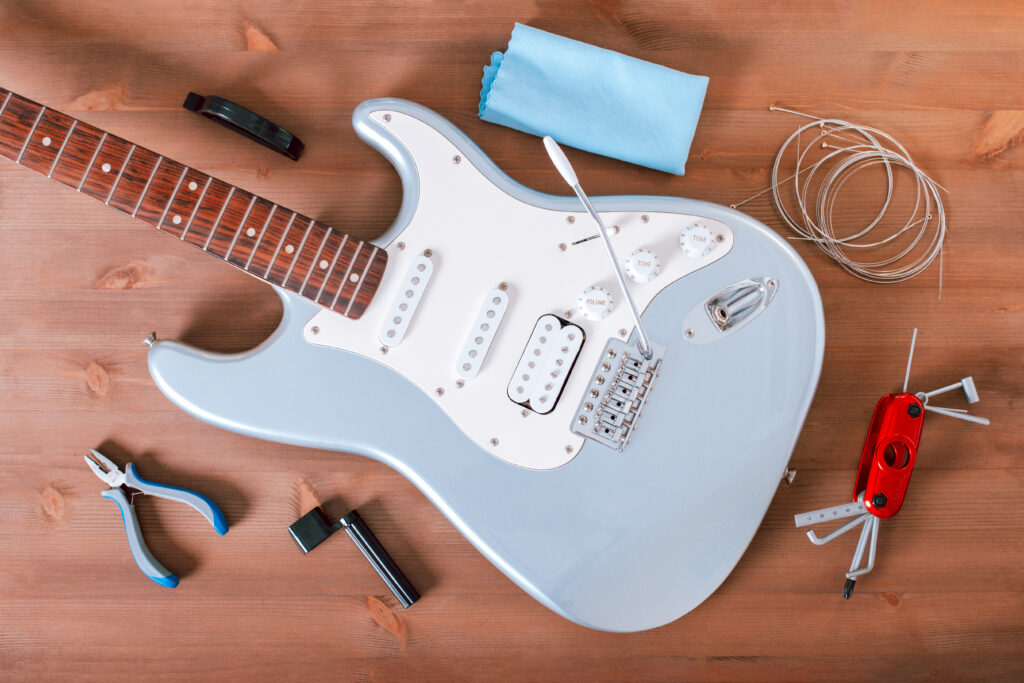
Coatings
Besides various metal coatings, there are also different synthetic materials to wrap the underlying cores in, the two most popular are nano and polyweb.
Nanoweb
This has a thin layer of polymer or synthetic wrapping, that way we can stay as close as possible to the pure metals or alloys in the string. The idea is that we do not want to cut out certain highs and lows provided by the signal.
Polyweb
Polyweb strings have more polymers in the coating to make the strings last a long time. It’s up to the player if they think enough sound quality is sacrificed for a better shelf life. There is not an exact coating that is best for any style, it is a matter of trying them out and finding what your ears prefer.
Jump Back To The Start

Windings
How the metals and materials are wrapped can also influence the final sound, and as always it depends on your style and technique that may make one winding better than another.
Roundwound
These are the most common strings. They’re made with wire that’s wound around a specific style of core. These are probably the best ones to try first as they have the most versatile uses.
Flatwound
As the name suggests these are an outer wire that is wound in a flat manner and popular among jazz and bluegrass players. But they can also not have as bright of a sound compared to round wound strings. And of course, they have some windings that mix both round and flat wires called halfrounds!
Jump Back To The Start
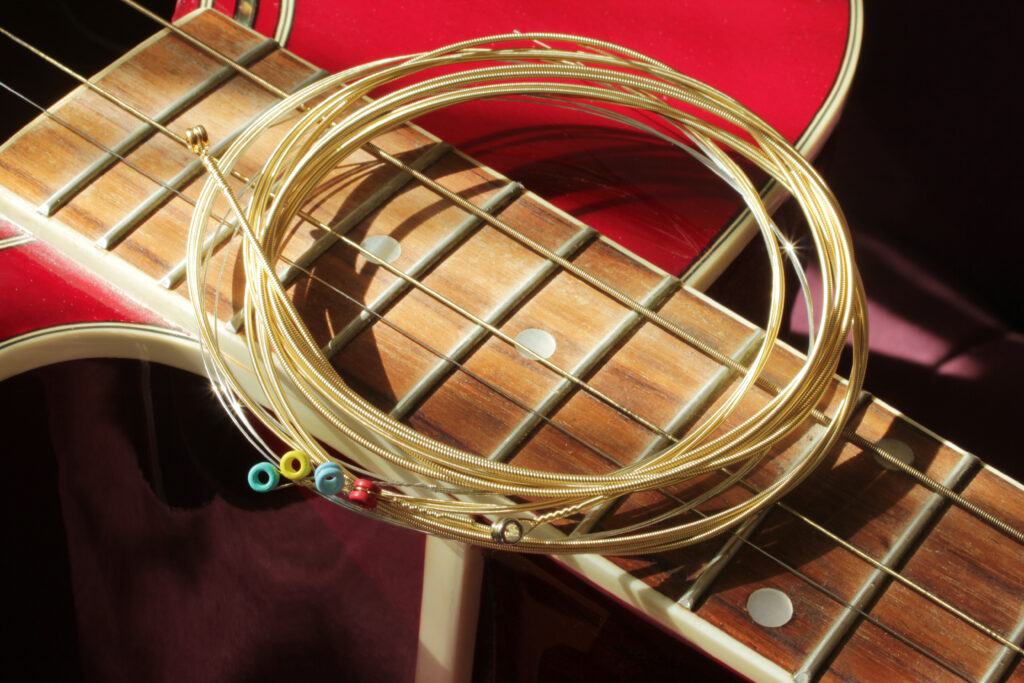
String Gauges and Sizes
The thickness of the string can vary and acoustic guitar strings must be thicker than electrics to help produce more sound. There are no exact measurements for each level and they can vary.
Always check your guitar model to see what thickness, gauge, or tension level is recommended.
Extra-Light
These are the thinnest strings and have the easiest playability as they feel great on the fingers, but they will also break more. Usually, electric guitarists that shred are looking for extra light gauge strings.
Light
This is a compromise for having excellent playability and yet less chance of one of the treble strings breaking. If you are completely new to strings, stick to light the first time as it is more comfortable for the fingers.
Medium
Our next step up is going to be louder and less bright, which means great for hard rock or blues. Acoustic guitars will sound better with a medium size as those give a great projection and aren’t as hard to play as heavy strings.

Heavy
These are the hardest to play but they will also provide a great bass tone. If you are looking for a very heavy sound beware of going too thick in string gauge. You must be certain your guitar, nut, and saddle were made to handle such a heavy string.
Nylon
Classical and nylon strings are labelled according to their level of tension, and they are rated in the same manner from normal to high.
Jump Back To The Start
Which Strings Are Best For You?
There are a lot of different types of guitar strings and it’s helpful to try different brands and styles to get an idea of what may suit your needs.
Keep the important rules in mind and don’t use the wrong materials and builds, otherwise experiment, and see which materials, gauges, and construction sound the best on your guitar.
Strings are so important when playing guitar, make sure you have the right ones and your tone will sound great. Grab your guitar tuner and a fresh pack of strings!